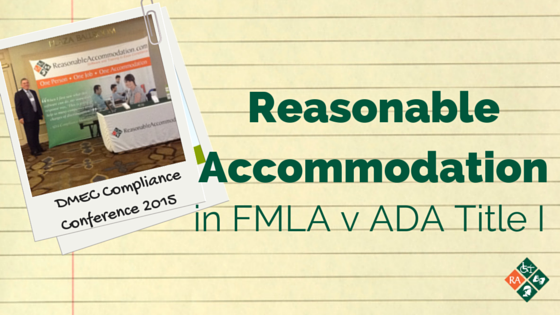
Roy at the 2015 DMEC Employer Compliance Conference in Washington, DC
I attended the DMEC FMLA/ADAAA Employer Compliance Conference in Washington, D.C. at the end of April. Following are my reflections on the general buzz throughout the conference and my private conversation with a defense attorney.
“Leave as an Accommodation” is a hot and worrisome topic among human resource and risk management professionals in attendance at the conference. This is reinforced by many of the phone calls we receive at the reasonableaccommodation.com office.
Looking closely at the subject we find that many FMLA veterans mistakenly bring their FMLA beliefs and habits into conversations about ADA Title I. That is, when discussing leave as a reasonable accommodation, they ask questions about setting corporate policies limiting the amount of leave they will allow under Title I. I believe this flows from the 12 week standard that lives in FMLA.
The law, and recent court decisions, does not allow us to pre-set responses to requests for accommodation under Title I of the amended ADA. Again, we cannot pre-set limits on what we will do to accommodate an otherwise qualified individual requesting an accommodation under Title I. Rules about the type of chair we will provide, how we will change the physical demands of a job, or how much leave we will allow runs contra to the spirit Congress intended to bring to the amended law. And that leads into the conversation with the attorney.
I spent a very nice half-hour talking shop with one of the presenters at the conference. This attorney is a partner, I believe, at one of the most respected employment law firms on the East Coast. As almost always happens, being able to listen with an open mind, ego in check, allowed me to learn a lot in a short amount of time. This was an attorney I could spend time with: no pretensions, willing to respond to questions from a rookie, and a good listener.
As we were standing in front of my Reasonable Accommodation Management Software booth, the attorney noticed the phrase “One Person, One Job, One Accommodation” written across the booth. Curious, he asked to what the phrase was referring. This was my opening to share with him one of the basic rules, in my experience, of managing a “hot” request for accommodation.
The idea behind One Person, One Job, One Accommodation came from a speech given by EEOC Commissioner Chai Feldblum during the Commission’s “Rock n’ Roll” tour in 2012. Her discussion of the interactive process caused me to reflect on the unspoken conversation flowing between the individual making a request for an accommodation and the human resource professional receiving the request. How does one best handle a difficult or seemingly rigid request? Is there a conversation style or tool to fall back on?
What’s essential to keep in mind is that each request for accommodation, like a leave of absence or intermittent leave request under Title I, comes from one individual, not an entire department. That individual must be otherwise qualified for the job to which he or she is attached. The error we make is worrying about the precedent that may be set by granting a request that may seem to be attractive to other department or group members. If other folks want this same accommodation they have to be qualified to request the accommodation and the accommodation must effectively address the disability issue they possess. Deal with them later, on an individual, one-to-one basis
The second part of the process becomes important when the requester wants a transfer. Remember, the individual owns the single job he was hired to perform and for which he is qualified. Don’t go down the path of discussing transfer to another job until you have exhausted options for keeping the individual in his current job.
The third part of the equation is one of those things you may want to reflect upon: when bombarded by suggestions for great accommodations, or when no accommodation seems feasible, focus on just one effective solution at a time. One person, one job, one accommodation. Find a single accommodation that works for you and for the employee. Be sure it works for the company: if you find that each potential request is declined secondary to a single, desired solution, something may be happening that is not as simple as it seems on the surface.


